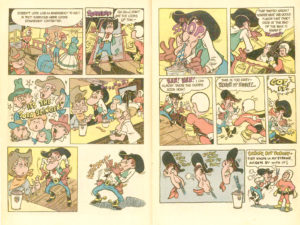When once it was hard to see comics and graphic novels as legitimate forms of literature, now it is hard to see them as having strict advertising or advertorial functions. You still see superheroes shilling product from time to time, but the pitching is kept relatively separate from the actual comics pages. Such was not the case only too recently. Comic Retribution looks at some of the low points — and occasional high points — when the medium was used as a marketing tool.
Where to begin with the Adventures of Captain Carvel? For background purposes, a little history is in order. You recognize Carvel today by the occasional ice cream joint much like their regularly cited competition Dairy Queen. Mostly you know them from the standalone freezer cases in grocery stores filled with circus-colored ice cream cakes. Now owned by a large corporation, Carvel is as removed from it’s roots as a company could get.
Early on however, and especially in the 1970s, they were a young upstart out of Tuckahoe, New York, run by gravel-voiced proprietor Tom Carvel. If you lived in the northeast United States then, you’ll recall his unique commercial narration.
Carvel is also the breeding ground for ice cream cake/characters like Cookie Puss, Fudgie The Whale, and illegal immigrant Cookie O’Puss. Why they needed their own superhero is lost to time, but indeed, they had their Captain Carvel, who was the central figure in a marketing comic book. And if there is one way to describe the book, it is: pernicious.
Nearly every panel on every page of this book dating back to 1975 is devoted to shilling Carvel products past parents and directly to kids. If you were a child, you wouldn’t be guilty if you thought Carvel ice cream made you stronger, happier, more social, and more benevolent.
And if you had a weight problem, the comic wanted to let you know that you too could eat lots of the company’s (at that time, dreadful tasting) Thinny Thin lowfat ice cream substitute, which was probably whipped ice milk. The comic book shows pleasant but necessarily rotund depictions of children gazing at the fun, friendly elephant offering them a treat. The point is not that ice cream, in its basic form, is not inherently bad if enjoyed in moderation. The tacit message is, “Don’t be a loser just because you’re fat. Eat our fat kids’ ice cream.”
Let’s not forget that the ’70s and early-’80s were a goldmine for cartoon-cum-pitchmen. The ultimate nadir of such was Joe Camel of Camel Cigarettes, but there were also Toucan Sam, Tony The Tiger, Dig ‘Em, Ronald McDonald and his merry band of costumed burger brigands. What Carvel was doing wasn’t actually so out of the ordinary.
But the hard sell throughout the comic book, and the fact it is fashioned as a comic book at all still disturbs. What’s more, if you notice the cover, there’s a price tag of 35 cents there. Not only were you hammering sales pitches to your kids, you were paying the going rate to inculcate them into the Cult of Carvel. Look at the masthead info on the first proper page of the book and you’ll see something else: this isn’t even a one-shot. The scans you’re viewing are from the third issue. This was an ongoing series of aggressive salesmanship!
 As a curio from that era, the book is an interesting look even as it is an enervating read. The art is cartoonish, but quite professional and stylish. Trust me. Many of these advertorial types of books weren’t.
As a curio from that era, the book is an interesting look even as it is an enervating read. The art is cartoonish, but quite professional and stylish. Trust me. Many of these advertorial types of books weren’t.
For your reading displeasure, click on the pages of the comic above to view the full pages. The rest of the book is linked below.






















Comments